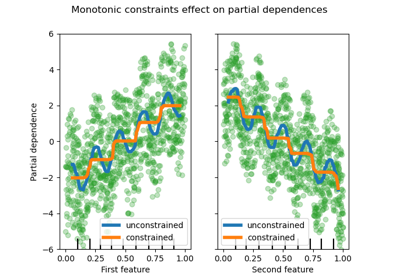注意
Go to the end to download the full example code or to run this example in your browser via JupyterLite or Binder.
直方图梯度提升树中的功能#
基于直方图的梯度提升 (HGBT) 模型可能是 scikit-learn 中最有用的监督学习模型之一。它们基于一种与 LightGBM 和 XGBoost 相当的现代梯度提升实现。因此,HGBT 模型比随机森林等替代模型具有更丰富的功能,并且通常表现更好,尤其是在样本数量超过数万时(参见比较随机森林和直方图梯度提升模型)。
HGBT 模型的主要可用性功能包括:
本示例旨在在实际环境中展示除第 2 点和第 6 点之外的所有要点。
# Authors: The scikit-learn developers
# SPDX-License-Identifier: BSD-3-Clause
准备数据#
电力数据集包含从澳大利亚新南威尔士州电力市场收集的数据。在这个市场中,价格不是固定的,受供需影响。它们每五分钟设定一次。与邻近的维多利亚州的电力传输/接收用于缓解波动。
该数据集最初名为 ELEC2,包含 45,312 个实例,日期从 1996 年 5 月 7 日到 1998 年 12 月 5 日。数据集中的每个样本代表 30 分钟的时间段,即每天有 48 个实例。数据集中的每个样本有 7 列:
date:1996 年 5 月 7 日至 1998 年 12 月 5 日之间。已归一化到 0 和 1 之间;
day:一周中的某一天(1-7);
period:24 小时内的半小时间隔。已归一化到 0 和 1 之间;
nswprice/nswdemand:新南威尔士州的电价/需求;
vicprice/vicdemand:维多利亚州的电价/需求。
最初,这是一个分类任务,但在这里我们将其用于回归任务,以预测州之间的计划电力传输。
from sklearn.datasets import fetch_openml
electricity = fetch_openml(
name="electricity", version=1, as_frame=True, parser="pandas"
)
df = electricity.frame
这个特定数据集的前 17,760 个样本的目标是阶梯常数。
df["transfer"][:17_760].unique()
array([0.414912, 0.500526])
让我们删除这些条目,并按一周中的不同日期探索每小时的电力传输。
import matplotlib.pyplot as plt
import seaborn as sns
df = electricity.frame.iloc[17_760:]
X = df.drop(columns=["transfer", "class"])
y = df["transfer"]
fig, ax = plt.subplots(figsize=(15, 10))
pointplot = sns.lineplot(x=df["period"], y=df["transfer"], hue=df["day"], ax=ax)
handles, labels = ax.get_legend_handles_labels()
ax.set(
title="Hourly energy transfer for different days of the week",
xlabel="Normalized time of the day",
ylabel="Normalized energy transfer",
)
_ = ax.legend(handles, ["Sun", "Mon", "Tue", "Wed", "Thu", "Fri", "Sat"])
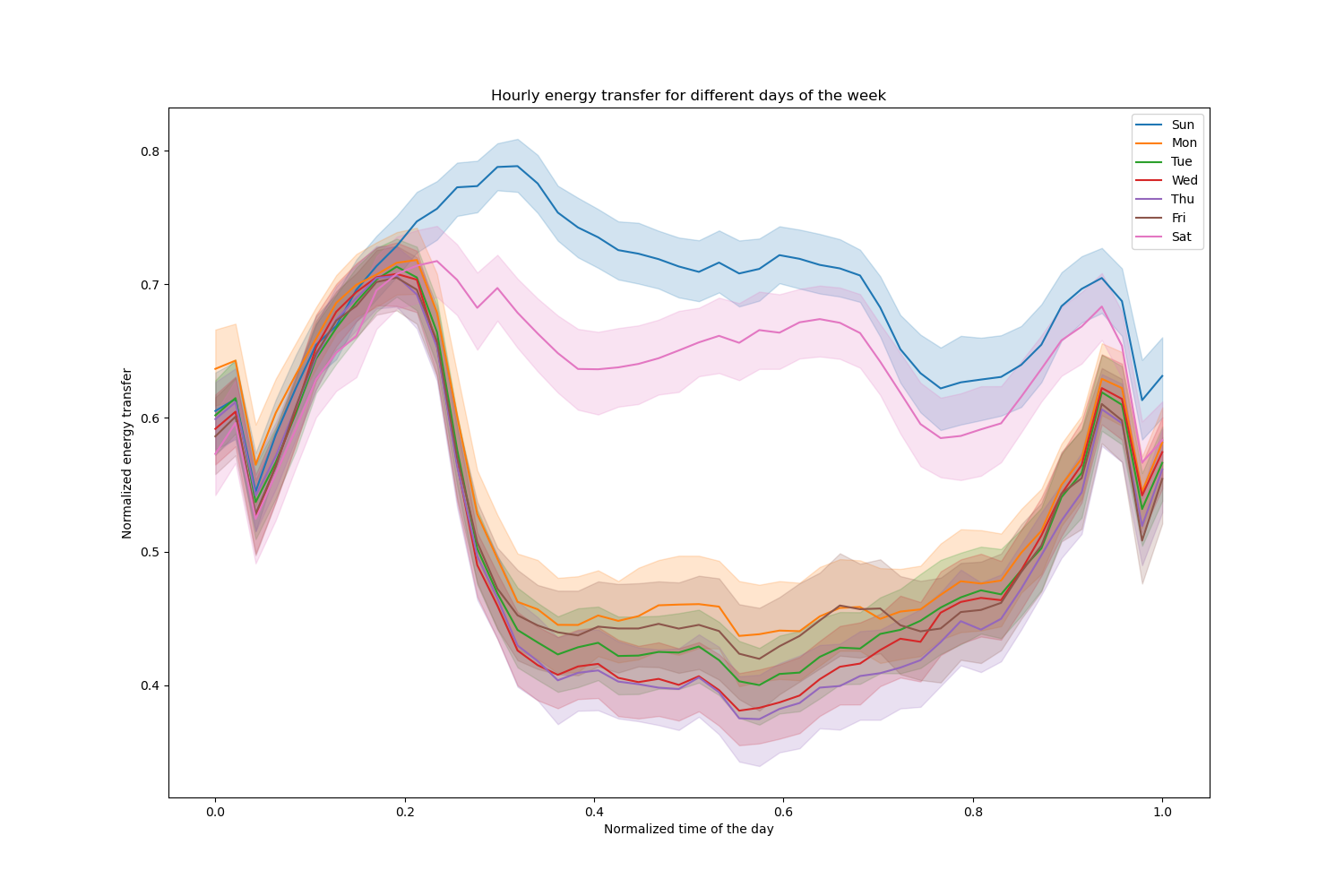
请注意,周末期间能源传输系统性增加。
树的数量和早停的影响#
为了说明(最大)树数量的影响,我们使用整个数据集对每日电力传输训练一个HistGradientBoostingRegressor。然后我们根据 max_iter 参数可视化其预测。在这里我们不尝试评估模型的性能及其泛化能力,而是评估它从训练数据中学习的能力。
from sklearn.ensemble import HistGradientBoostingRegressor
from sklearn.model_selection import train_test_split
X_train, X_test, y_train, y_test = train_test_split(X, y, test_size=0.4, shuffle=False)
print(f"Training sample size: {X_train.shape[0]}")
print(f"Test sample size: {X_test.shape[0]}")
print(f"Number of features: {X_train.shape[1]}")
Training sample size: 16531
Test sample size: 11021
Number of features: 7
max_iter_list = [5, 50]
average_week_demand = (
df.loc[X_test.index].groupby(["day", "period"], observed=False)["transfer"].mean()
)
colors = sns.color_palette("colorblind")
fig, ax = plt.subplots(figsize=(10, 5))
average_week_demand.plot(color=colors[0], label="recorded average", linewidth=2, ax=ax)
for idx, max_iter in enumerate(max_iter_list):
hgbt = HistGradientBoostingRegressor(
max_iter=max_iter, categorical_features=None, random_state=42
)
hgbt.fit(X_train, y_train)
y_pred = hgbt.predict(X_test)
prediction_df = df.loc[X_test.index].copy()
prediction_df["y_pred"] = y_pred
average_pred = prediction_df.groupby(["day", "period"], observed=False)[
"y_pred"
].mean()
average_pred.plot(
color=colors[idx + 1], label=f"max_iter={max_iter}", linewidth=2, ax=ax
)
ax.set(
title="Predicted average energy transfer during the week",
xticks=[(i + 0.2) * 48 for i in range(7)],
xticklabels=["Sun", "Mon", "Tue", "Wed", "Thu", "Fri", "Sat"],
xlabel="Time of the week",
ylabel="Normalized energy transfer",
)
_ = ax.legend()
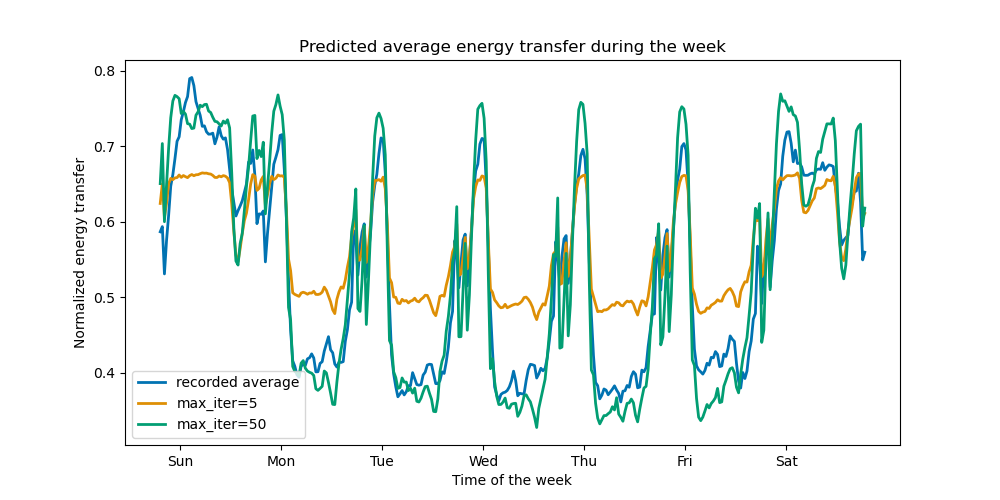
只需很少的迭代,HGBT 模型就可以达到收敛(参见比较随机森林和直方图梯度提升模型),这意味着添加更多树不会再改善模型。在上图中,5 次迭代不足以获得良好的预测。通过 50 次迭代,我们已经能够做得很好。
将 max_iter 设置得太高可能会降低预测质量,并导致大量可避免的计算资源开销。因此,scikit-learn 中的 HGBT 实现提供了一种自动早停策略。通过该策略,模型使用一小部分训练数据作为内部验证集(validation_fraction),如果验证分数在 n_iter_no_change 次迭代后没有改善(或降低)到一定容差(tol),则停止训练。
请注意 learning_rate 和 max_iter 之间存在权衡:通常,较小的学习率更可取,但需要更多的迭代才能收敛到最小损失,而较大的学习率收敛更快(需要的迭代/树更少),但代价是最小损失更大。
由于学习率和迭代次数之间存在高度相关性,一种好的做法是调整学习率以及所有(重要)其他超参数,在训练集上使用足够大的 max_iter 值拟合 HBGT,并通过早停和一些明确的 validation_fraction 确定最佳的 max_iter。
common_params = {
"max_iter": 1_000,
"learning_rate": 0.3,
"validation_fraction": 0.2,
"random_state": 42,
"categorical_features": None,
"scoring": "neg_root_mean_squared_error",
}
hgbt = HistGradientBoostingRegressor(early_stopping=True, **common_params)
hgbt.fit(X_train, y_train)
_, ax = plt.subplots()
plt.plot(-hgbt.validation_score_)
_ = ax.set(
xlabel="number of iterations",
ylabel="root mean squared error",
title=f"Loss of hgbt with early stopping (n_iter={hgbt.n_iter_})",
)
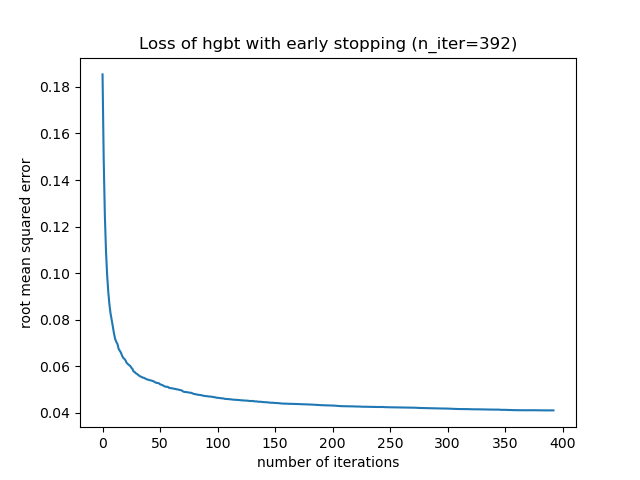
然后,我们可以将 max_iter 的值覆盖为一个合理的值,并避免内部验证的额外计算成本。将迭代次数向上取整可以考虑到训练集的变异性。
import math
common_params["max_iter"] = math.ceil(hgbt.n_iter_ / 100) * 100
common_params["early_stopping"] = False
hgbt = HistGradientBoostingRegressor(**common_params)
注意
在早停期间进行的内部验证对于时间序列不是最优的。
对缺失值的支持#
HGBT 模型具有对缺失值的原生支持。在训练期间,树生长器根据潜在的增益决定具有缺失值的样本在每次分裂时应该去哪里(左子节点还是右子节点)。在预测时,这些样本会相应地发送到学习到的子节点。如果一个特征在训练期间没有缺失值,那么对于预测,该特征具有缺失值的样本将被发送到具有最多样本的子节点(如拟合期间所见)。
本示例展示了 HGBT 回归如何处理完全随机缺失 (MCAR) 的值,即缺失与观察到的数据或未观察到的数据无关。我们可以通过随机选择特征并随机替换值为 nan 来模拟这种情况。
import numpy as np
from sklearn.metrics import root_mean_squared_error
rng = np.random.RandomState(42)
first_week = slice(0, 336) # first week in the test set as 7 * 48 = 336
missing_fraction_list = [0, 0.01, 0.03]
def generate_missing_values(X, missing_fraction):
total_cells = X.shape[0] * X.shape[1]
num_missing_cells = int(total_cells * missing_fraction)
row_indices = rng.choice(X.shape[0], num_missing_cells, replace=True)
col_indices = rng.choice(X.shape[1], num_missing_cells, replace=True)
X_missing = X.copy()
X_missing.iloc[row_indices, col_indices] = np.nan
return X_missing
fig, ax = plt.subplots(figsize=(12, 6))
ax.plot(y_test.values[first_week], label="Actual transfer")
for missing_fraction in missing_fraction_list:
X_train_missing = generate_missing_values(X_train, missing_fraction)
X_test_missing = generate_missing_values(X_test, missing_fraction)
hgbt.fit(X_train_missing, y_train)
y_pred = hgbt.predict(X_test_missing[first_week])
rmse = root_mean_squared_error(y_test[first_week], y_pred)
ax.plot(
y_pred[first_week],
label=f"missing_fraction={missing_fraction}, RMSE={rmse:.3f}",
alpha=0.5,
)
ax.set(
title="Daily energy transfer predictions on data with MCAR values",
xticks=[(i + 0.2) * 48 for i in range(7)],
xticklabels=["Mon", "Tue", "Wed", "Thu", "Fri", "Sat", "Sun"],
xlabel="Time of the week",
ylabel="Normalized energy transfer",
)
_ = ax.legend(loc="lower right")
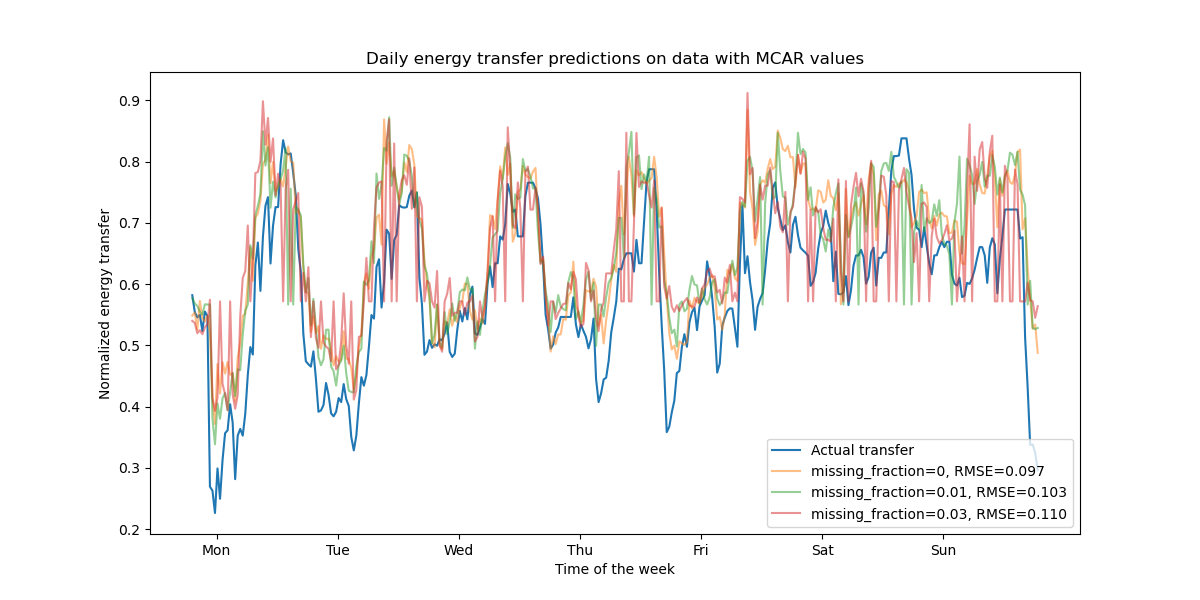
正如预期的那样,随着缺失值比例的增加,模型性能会下降。
对分位数损失的支持#
回归中的分位数损失可以提供目标变量变异性或不确定性的视图。例如,预测第 5 个百分位和第 95 个百分位可以提供 90% 的预测区间,即我们期望新观察值以 90% 的概率落入的范围。
from sklearn.metrics import mean_pinball_loss
quantiles = [0.95, 0.05]
predictions = []
fig, ax = plt.subplots(figsize=(12, 6))
ax.plot(y_test.values[first_week], label="Actual transfer")
for quantile in quantiles:
hgbt_quantile = HistGradientBoostingRegressor(
loss="quantile", quantile=quantile, **common_params
)
hgbt_quantile.fit(X_train, y_train)
y_pred = hgbt_quantile.predict(X_test[first_week])
predictions.append(y_pred)
score = mean_pinball_loss(y_test[first_week], y_pred)
ax.plot(
y_pred[first_week],
label=f"quantile={quantile}, pinball loss={score:.2f}",
alpha=0.5,
)
ax.fill_between(
range(len(predictions[0][first_week])),
predictions[0][first_week],
predictions[1][first_week],
color=colors[0],
alpha=0.1,
)
ax.set(
title="Daily energy transfer predictions with quantile loss",
xticks=[(i + 0.2) * 48 for i in range(7)],
xticklabels=["Mon", "Tue", "Wed", "Thu", "Fri", "Sat", "Sun"],
xlabel="Time of the week",
ylabel="Normalized energy transfer",
)
_ = ax.legend(loc="lower right")
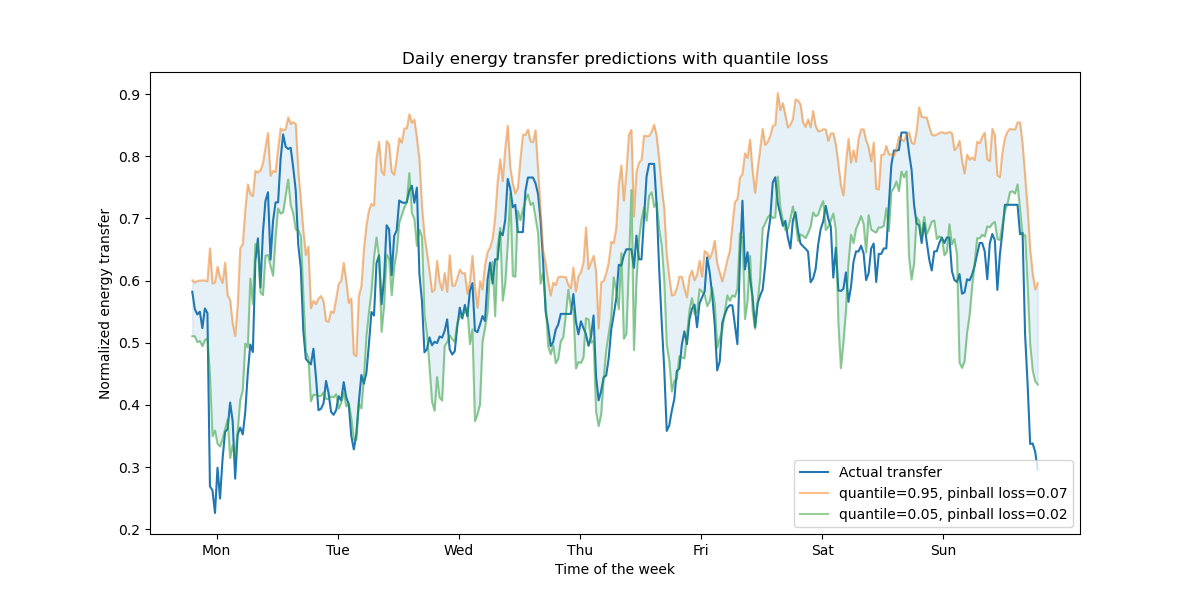
我们观察到能源传输有高估的趋势。这可以通过计算经验覆盖率来定量证实,如置信区间校准部分所示。请记住,这些预测的百分位数只是来自模型的估计。我们仍然可以通过以下方式提高这些估计的质量:
收集更多数据点;
更好地调整模型超参数,参见梯度提升回归的预测区间;
从相同数据中工程出更多预测性特征,参见时间相关特征工程。
单调约束#
给定特定的领域知识要求特征与目标之间的关系单调增加或减少,可以使用单调约束在 HGBT 模型的预测中强制执行这种行为。这使得模型更具可解释性,并且可以减少其方差(并可能减轻过拟合),但可能会增加偏差的风险。单调约束还可用于强制执行特定的监管要求,确保合规性并符合道德考虑。
在本示例中,将能源从维多利亚州传输到新南威尔士州的政策旨在缓解价格波动,这意味着模型预测必须强制执行这一目标,即传输应随着新南威尔士州的价格和需求增加,但随着维多利亚州的价格和需求减少,以使两个地区都受益。
如果训练数据具有特征名称,可以通过传递一个字典来指定单调约束,约定如下:
1:单调增加
0:无约束
-1:单调减少
或者,可以传递一个数组状对象,按位置编码上述约定。
from sklearn.inspection import PartialDependenceDisplay
monotonic_cst = {
"date": 0,
"day": 0,
"period": 0,
"nswdemand": 1,
"nswprice": 1,
"vicdemand": -1,
"vicprice": -1,
}
hgbt_no_cst = HistGradientBoostingRegressor(
categorical_features=None, random_state=42
).fit(X, y)
hgbt_cst = HistGradientBoostingRegressor(
monotonic_cst=monotonic_cst, categorical_features=None, random_state=42
).fit(X, y)
fig, ax = plt.subplots(nrows=2, figsize=(15, 10))
disp = PartialDependenceDisplay.from_estimator(
hgbt_no_cst,
X,
features=["nswdemand", "nswprice"],
line_kw={"linewidth": 2, "label": "unconstrained", "color": "tab:blue"},
ax=ax[0],
)
PartialDependenceDisplay.from_estimator(
hgbt_cst,
X,
features=["nswdemand", "nswprice"],
line_kw={"linewidth": 2, "label": "constrained", "color": "tab:orange"},
ax=disp.axes_,
)
disp = PartialDependenceDisplay.from_estimator(
hgbt_no_cst,
X,
features=["vicdemand", "vicprice"],
line_kw={"linewidth": 2, "label": "unconstrained", "color": "tab:blue"},
ax=ax[1],
)
PartialDependenceDisplay.from_estimator(
hgbt_cst,
X,
features=["vicdemand", "vicprice"],
line_kw={"linewidth": 2, "label": "constrained", "color": "tab:orange"},
ax=disp.axes_,
)
_ = plt.legend()
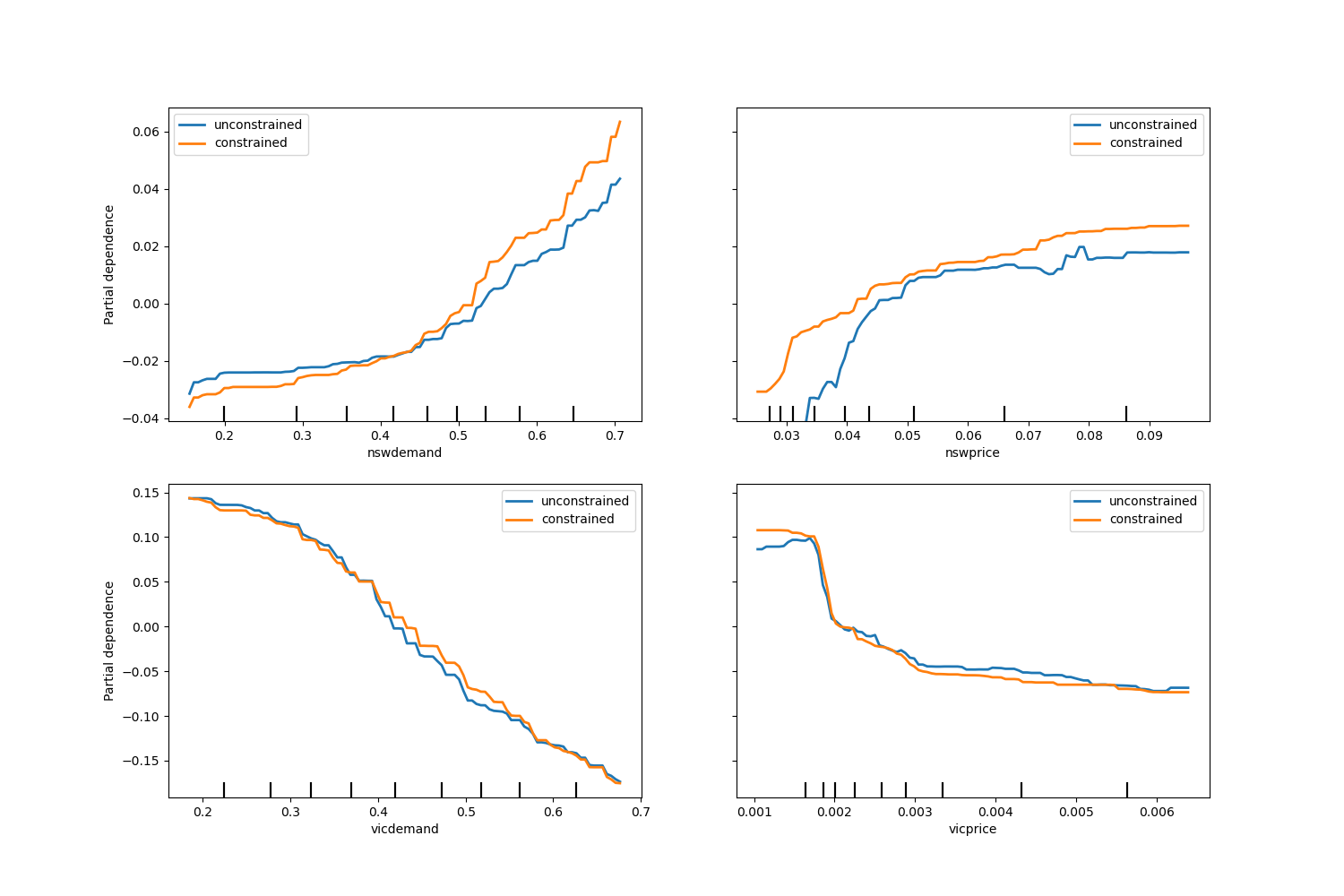
请注意,nswdemand 和 vicdemand 似乎在没有约束的情况下已经是单调的。这是一个很好的例子,表明具有单调约束的模型是“过度约束”的。
此外,我们可以验证引入单调约束后模型的预测质量没有显着降低。为此,我们使用TimeSeriesSplit交叉验证来估计测试分数的方差。通过这样做,我们保证训练数据不会出现在测试数据之后,这在处理具有时间关系的数据时至关重要。
from sklearn.metrics import make_scorer, root_mean_squared_error
from sklearn.model_selection import TimeSeriesSplit, cross_validate
ts_cv = TimeSeriesSplit(n_splits=5, gap=48, test_size=336) # a week has 336 samples
scorer = make_scorer(root_mean_squared_error)
cv_results = cross_validate(hgbt_no_cst, X, y, cv=ts_cv, scoring=scorer)
rmse = cv_results["test_score"]
print(f"RMSE without constraints = {rmse.mean():.3f} +/- {rmse.std():.3f}")
cv_results = cross_validate(hgbt_cst, X, y, cv=ts_cv, scoring=scorer)
rmse = cv_results["test_score"]
print(f"RMSE with constraints = {rmse.mean():.3f} +/- {rmse.std():.3f}")
RMSE without constraints = 0.103 +/- 0.030
RMSE with constraints = 0.107 +/- 0.034
话虽如此,请注意比较的是两个不同的模型,它们可能通过不同的超参数组合进行优化。这就是为什么我们没有像以前那样在本节中使用 common_params。
脚本总运行时间: (0 minutes 18.194 seconds)
相关示例


